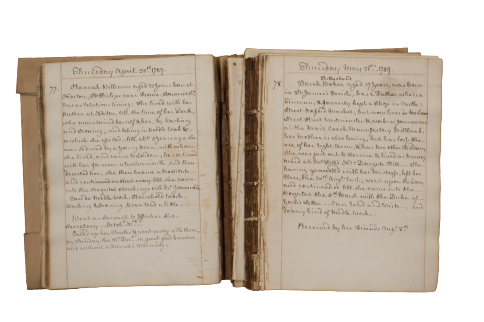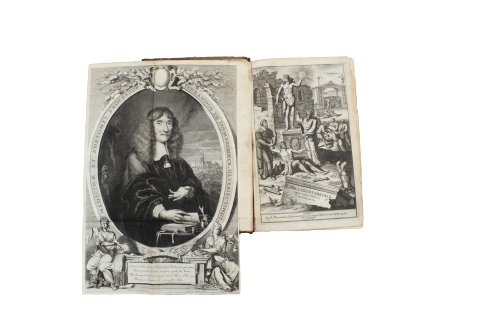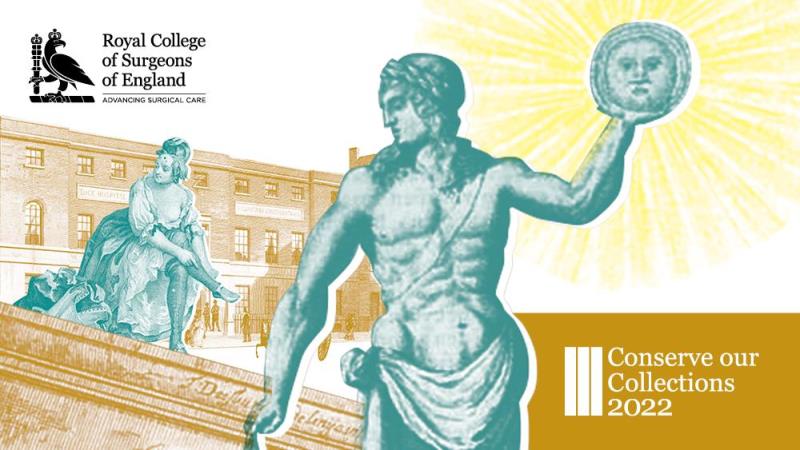Conserve our Collections Appeal 2022: Revive the Age of Enlightenment & Rediscover our Stories
Help us conserve treasured items for future generations
Each item and object in RCS England’s archives and collections is rich with significance and context in its own right and sometimes, as we dig deeper, themes emerge which are surprisingly relevant today.
This year we are conserving nine original texts on a broad continuum from 1554 to 1895 for which the themes of reviving the enlightenment and marginalised figures resonate through. Each piece provides us with glimpses into the major tectonic shifts in thinking from Europe’s most noted Enlightenment thinkers as well as specific stories of female doctors and patients in late Victorian London.
As ever, we need your help to help ensure that they survive, so that they can be made accessible to future generations. Please donate today to ensure that these items can be preserved for many years to come.
The fact that women have been treated differently from men throughout the history of medicine, whether as practitioners or patients, is uncontested. That this was done methodically and with the best of intentions is harder for us to justify today, even as work to improve equity and access must continue. RCS England’s texts from the Lock Asylum, London tell this story in personal detail from the perspective of doctors and patients; and the Petition for the Admission of Women to College Examinations lists the original signatures of people fighting for the right of women.
London Lock Asylum Female Patient Histories, 1787– 1808
(MS0022/6/10)
Founded in 1746 by surgeon William Bromfield and partially staffed by early Fellows of the College, The Lock Hospital was London’s first voluntary hospital for the treatment of venereal diseases. This volume comprises 220 handwritten biographies of female patients who were referred to the ‘Lock Asylum for the Reception of Penitent Female Patients’ after their treatment in the hospital. They were taught needlework and other skills useful to life in domestic service. These were typically young women, some orphaned or without family, others simply unfortunate in love. Many had experienced abuse and worked as prostitutes. This volume is a unique source of evidence on a group of 18th century women whose lives were hidden at the time and are rarely represented in archives.

Condition: Bound account book of laid paper, ruled with red ink, with manuscript in iron-gall ink. The outer boards and endpapers are entirely missing, and the binding is broken. The block measures 240mm x 195mm x 40mm, with 18 sections of 10 pages each. The first three sections are in bad condition, with surface dirt, creases and tears. Some double pages are split. The current binding is too tight to digitise the pages.
Estimated conservation cost: £585.00
London Lock Asylum Committee Minute Book, 1787– 1811
(MS0022/2/1/1)
This is the first minute book of the London Lock Asylum. It documents how and why this unique institution for the rehabilitation of ‘fallen women’ who had been treated for venereal disease was founded. The minutes include details of the Subscribers who funded the Asylum, its governance, rules and regulations for the women patients, and the role of the matron. It also gives information on the ‘behaviour ’ of individual women patients.

Condition: Bound notebook with manuscript ink. The front cover is separate from the text block and is in poor condition. The binding is broken, gatherings have separated and some leaves are completely loose. Front inside pages have surface dirt. Some pages are brittle.
Estimated conservation cost: £500.00
Petition for the Admission of Women to College Examinations, 1895
(RCS-GOV/2/7/11)
This document is of profound significance in the history of the College as it led to women being admitted to College examinations after a 45-year campaign led by Elizabeth Garrett Anderson. It includes the original signatures of Garrett Anderson, Dame Mary Scharlieb and many others.

Condition: The petition is manuscript in black ink on 7 pages of laid paper attached with a legal tie in the top left hand corner, 392mm x 248mm. On the final two pages, the original signatures are adhered with paste. In the past the document has been stored folded and all the pages have broken along this fold line; the paper is slightly discoloured along this break. There is some surface dirt on the first page.
Estimated conservation cost: £200.00 - £250.00
Reviving Enlightenment
The earliest of the texts under this theme is dated 1554, 102 years after the Gutenberg Bible, and only 11 years after Copernicus hypothesised that our planets orbit the sun. Scientific leaps forward, whether radical or tentative, were no doubt devoured by the Company of Barber Surgeons, established in 1540.
Dissertationes Medicae by Archibald Pitcairn, Rotterdam 1701
Archibald Pitcairn (1652 – 1713) was a Scottish physician and poet who practised in Edinburgh from around 1681. In this book he hypothesises that Newtonian physics more accurately describe bodily functions than the balance of humours, and discusses the circulation of the blood in the smaller vessels, the motions by which food becomes fit to supply the blood, the cure of fevers by evacuating medicines, the effects of acids and alkalis in medicine, and innovators in medicine including William Harvey and Hippocrates. Pitcairn famously corresponded with Isaac Newton himself and even visited him on a journey to Leiden in 1692.

Condition: Top board detached, bottom board starting to detach, hinges cracked.
Estimated conservation cost: £200.00 - £250.00
Wisdom of God by John Ray, London, 1714 (6th edition)
In the 1690s Ray published three volumes on religion. The Wisdom of God Manifested in the Works of the Creation (1691) was an essay in natural religion that called on the full range of his biological learning and was his most popular and influential book. It argues that the correlation of form and function in organic nature demonstrates the necessity of an omniscient creator. This argument for design within nature, common to most of the leading scientists of the 17th century, implies a static view of nature that was distinctly different from the evolutionary ideas of the early and mid-19th century.

Condition: Both boards detached. A fine binding with inlaid stamped mottled calf, gilt stamped spine. With Bookplate of George Arnold – a member of the Privy Chamber.
Estimated conservation cost: £200.00 - £250.00
Synops methodica Animalium Quadrupedum et sepentini by John Ray, London, 1693
In this work Ray turns his hand to taxonomy. Instead of a single feature, he attempts to classify by looking at all the structural characteristics, including internal anatomy. By insisting on the importance of lungs and cardiac structure he establishes the class of the mammal, and he classifies insects according to the presence or absence of metamorphoses. Although a truly natural system of taxonomy could not be realised before the age of Darwin, Ray’s system approached that goal more than the frankly artificial systems of his contemporaries. He was one of the great predecessors who made possible Carolus Linnaeus’ contributions in the following century.

Condition: Top board almost detached, very fragile, leather flaking off, rebacked new spine speckled calf.
Estimated conservation cost: £200.00 - £250.00
De Vulneribus Sclopetorum by Francisci Plazzoni, Padua, 1643
An early treatise on gunshot wounds. The literal translation of the title is ‘Tract on the wounds of gunners; In which their nature, and the perfect treatment, the surgical method are explained, and the symptoms which accompany these wounds are carefully corrected’.

Condition: Top board detached, back board cracked and fragile.
Estimated conservation cost: £300.00 - £450.00
Opera omnia anatomica et medica by Isbrand van Diemerbroeck, Utrecht, 1685
Isbrand van Diemerbroeck was a Dutch physician, 1609. He studied first in Utrecht, then in 1609. He studied first in Utrecht, then in Leiden, receiving his doctorate in medicine from the University of Angers. He worked in Nijmegen in 1635 and 1636, during the Black Death and described his experiences treating the plague in his 1646 work De Peste. Three years later he became a professor of medicine and anatomy at the University of Utrech, where he was twice appointed Rector and Regnier de Graaf was his pupil. This volume of collected works was edited by his son, Tieman, also a physician, and contains his extensive work on anatomy.

Condition: Rebacked calf, new joints and hinges cracking badly, detached along part of the splitting hinges.
Estimated conservation cost: £300.00 - £450.00
Medicina by Jean Fernel, Paris, 1554
This work introduced the term ‘pathology’ in its modern sense, being the first explicit treatise on the subject, as well as naming the science of physiology. In the second part, entitled “Pathologia,” Fernel provided the first systematic essay on the subject, methodically discussing the diseases of each organ. Fernel was the first to describe appendicitis, endocarditis among others. He believed aneurysms to be produced by syphilis and differentiated true from false aneurysms. Alongside his writing, Fernel was physician to Henry II of France.

Condition: Joints and hinges very fragile, rebacked with new spine upbraided and flaky, splitting badly at tail end of spine, with small pieces of calf missing.
Estimated conservation cost: £300.00 - £450.00
Please donate today - every penny will help to conserve the College's collections
We look forward to keeping you updated with the progress of conservation.

